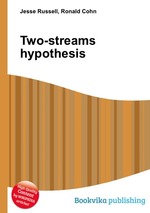Two-streams hypothesis
Jesse Russell Ronald Cohn
бумажная книга
High Quality Content by WIKIPEDIA articles! The two-streams hypothesis is a widely accepted and influential model of the neural processing of vision. The hypothesis, given its most popular characterisation in a paper by David Milner and Melvyn A. Goodale in 1992, argues that humans possess two distinct visual systems. As visual information exits the occipital lobe, it follows two main pathways, or "streams". The ventral stream (also known as the "what pathway") travels to the temporal lobe and is involved with object identification and recognition. The dorsal stream (or, "how pathway") terminates in the parietal lobe and is involved with processing the objects spatial location relevant to the viewer.


